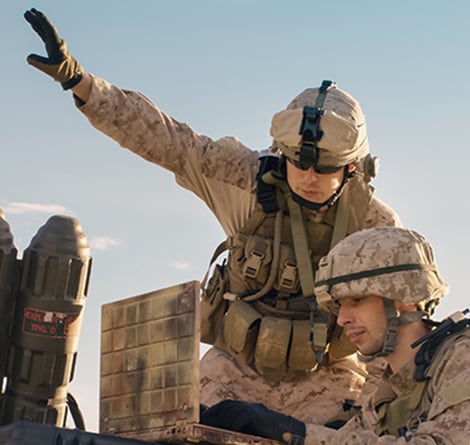
Tested and Proven for Military Use
Relays and contactors qualified to military qualified (MIL-Spec) standards are tested and proven capable of addressing the electrical and environmental requirements for aircraft, missile, spacecraft, ship, and other primary vehicles, including ground support and shipboard equipment applications.
Military qualified relays and contactors have features and capabilities that differentiate them from industrial relays. There are two basic types of switching devices that are MIL qualified: electromechanical and solid state.
Our MIL-Spec electromechanical relays and contactors have physical contacts that mechanically open and close the switched circuit and an electromagnetic coil circuit that controls the opening and closing of the contacts. Basic contact resistive load ratings for relays is 25 amps and less, and for contactors 25 amps and above.
A solid state relay (SSR), on the other hand, has a semiconductor switch that is controlled on and off by a solid state control circuit and a SSR contains no moving parts.
Understanding industrial relays and MIL-qualified relays. Our industrial relays - those in our Potter & Brumfield, Schrack, and Axicom portfolios - typically have a UL or CSA rating. Our MIL-performance relays - from our brands CII, HARTMAN, and KILOVAC - are generally qualified or screened to a MIL spec, such as M6106, M83726, M83536, M32085, and M83725. Industrial relays are commonly plastic encased and environmentally sealed. MIL-performance products are generally hermetically sealed and are metal housed. Industrial relays are typically used in appliance, automotive, computer, and/or consumer products. MIL-performance devices are generally used in medical, aerospace, military, and harsh/high reliability environments.
Our high-performance group (HPG) of relays - which includes solutios from our CII, HARTMAN, and KILOVAC brands - has the most MIL qualified products in the industry. CII is the only relay manufacturer to be qualified at the most reliable “P” failure rate level for MIL-PRF-39016.
Technical Features
Features to consider when selecting the proper MIL-Spec relay or contactor for your application include load type, voltage, maximum current, and frequency (AC only). These and other options are discussed in more detail below.
Application Loads
Resistive, motor, inductive, capacitive, and lamp loads are common application loads. Generally, resistive ratings are used as the default current rating for a device. Other current levels will vary depending on the load type. For example, a relay with a 10 amp, 28 Vdc resistive rating may be rated at 8 amp for inductive load, 4 amp for motor load, and/or 2 amp for lamp load. One of the keys to relay longevity is knowing the load and application’s related conditions.
Coil Voltage and Configuration
Common coil voltage ratings are 5/6, 12, or 24/28 Vdc, and 115/230 Vac/400Hz. Other voltage options may be available by request. Coil configurations are electrically held or latching coil, where applicable. Latching coil is not available for SSR.
Contact Configuration
Examples of contact configurations include SPST (single pole single throw), DPST (2 pole single throw), SPDT (single pole double throw), DPDT (double pole double throw), 3PDT (3 pole double throw), and 4PDT (4 pole double throw). Common configurations include Form A (SPST, normally open) and Form C (SPDT, normally open and normally closed).
Terminal Type
Depending on the product, available terminal options are typically solder pin terminal (for PCB), solder hook (for wire harness), socket pin mount (for relay socket mount), and threaded terminal (lug/bus bar mount).
Mounting Style
Mounting styles for MIL-Spec relays and contactors are plain case (no flange), HFM (horizontal flange mount), RVFM (raised vertical flange mount), and other options available where applicable.
Additional Considerations
Additional considerations for MIL-Spec relays and contactors include but are not limited to: altitude, salt spray, fog, humidity, temperature, mechanical shock, and/or vibration. Specifications like MIL-STD-202 (testing methods for electronic and electrical component parts) define testing standards, which include relays and contactors. It is important to cover these parameters as they can be critical in choosing the correct product for the application. Furthermore, MIL-Specs like M39016 (2 amp relays), M83536 (5, 10, and 25 amp relays), M5757 (5 and 10 amp relays), M83726 (10 amp time delays), M6106 (25 amps and higher contactors), and M32085 (270 Vdc contactors), can be used as a baseline guide regarding relay and contactor requirements.
MIL-Spec Relays and Contactors in Select Applications
DLA MIL-Spec Relays
The Defense Logistics Agency’s (DLA), MIL qualified relays are designed and screened for harsh conditions. QPLs (Qualified Product Listing) or QPDSIS (Qualified Products Database Supplemental Information Sheet) are cross reference documents that list products and manufacturers qualified to the relevant specification detail.
Common QPLs/QPDSIS for electromechanical relays and contactors are: QPDSIS-6106 (25 - 400 amps), QPDSIS-83536 (5-25 amps), QPDSIS-5757 (5-10 amps), QPDSIS-83726 (time delays), QPDSIS-39016 (2 amps), and QPDSIS-83725 (vacuum relays). Each one of these documents has a corresponding MIL-Specification: MIL-PRF-6106 (25 - 400 amps), MIL-PRF-83536 (5-25 amps), MIL-PRF-39016 (2 amps), and MIL-DTL-83725 (vacuum relays).
Common MIL specs for SSRs are: MIL-PRF-28750 (solid state) and MIL-PRF-28776 (solid state/hybrid). The corresponding QPLs are QPDSIS-28750 and QPDSIS-28776.
Find Relays for Your Design
Socket to Relay
| Military Socket P/N | Relay Part Number | Relay Type |
|---|---|---|
| M12883/40-01 | ||
| M12883/40-05 | ||
| M12883/40-07 | ||
| M12883/40-11 | M83536/15-022 | 4 Pole, 10 Amp |
| M12883/40-13 | M83536/16-006, 014, 031, 034 | |
| M12883/40-17 | ||
| M12883/40-19 | ||
| M12883/40-23 | ||
| M12883/40-02 | ||
| M12883/40-08 | FCA-410-DY8 (Catalog Version) | 4 Pole, 10 Amp, AC |
| M12883/40-14 | FCA-410-DY9 (Catalog Version) | |
| M12883/40-20 | ||
| M12883/41-01 | ||
| M12883/41-04 | ||
| M12883/41-06 | ||
| M12883/41-09 | M83536/9-006, 015, 024, 035 | 2 Pole, 10 Amp |
| M12883/41-11 | M83536/10-006, 015, 024, 034, 038 | |
| M12883/41-14 | ||
| M12883/41-16 | ||
| M12883/41-19 | ||
| M12883/41-02 | ||
| M12883/41-07 | FCA-210-DY8 (Catalog Version) | 2 Pole, 10 Amp, AC |
| M12883/41-12 | FCA-210-DY9 (Catalog Version) | |
| M12883/41-17 | ||
| M12883/44-01 | M83536/5-006, 014, 022, 030 | |
| M83536/6-006, 014, 022, 032 | 4 Pole, 5 Amp | |
| M12883/45-01 | M83536/1-006, 015, 024, 033 | |
| M83536/2-006, 015, 024, 035 | 2 Pole, 5 Amp | |
| M12883/47-01 | ||
| M12883/47-04 | FCA-610-AY3 (Catalog Version) | |
| M12883/47-07 | FCA-610-AY4 (Catalog Version) | 6 Pole, 10 Amp |
| M12883/47-02 | ||
| M12883/47-05 | FCA-610-DY8 (Catalog Version) | 6 Pole, 10 Amp |
| M12883/47-08 | AC | |
| M12883/47-11 | ||
| M12883/48-01 | ||
| M12883/48-02 | M83536/32-003L | 3 Pole, 25 Amp |
| M12883/48-03 | M83536/33-003L | |
| M12883/48-04 | ||
| M12883/48-05 | ||
| M12883/48-06 | FCA-325-AV8 (Catalog Version) | 3 Pole, 25 Amp |
| M12883/48-07 | FCA-325-AV9 (Catalog Version) | AC |
| M12883/48-08 | ||
| M12883/52-01 | M83536/02-028 | 2 Pole, 5 Amp |
| Track Mount | ||
| M12883/52-02 | M83536/6-025 | 4 Pole, 5 Amp |
| Track Mount | ||
| M12883/55-01 | ||
| M12883/55-02 | M6106/19-004, 007, 012, 017, 022 |
Our CII mid-range relays offer critical size and weight savings in aircraft applications by providing efficient power switching in a compact package. These relays vary in size from the compact 5 amp package all the way up to a 50 amp version in a 1 inch cube enclosure. In this catalog, you can learn about our CII FCB-205 relay and our CII FCB-405 relay. Our FCB-205 relay is a polarized single-side stable design, where the flux from a permanent magnet provides the armature holding force in the deactivated state, and its flux path is switched and combined with the coil flux in the operated state. This results in appreciably increased contact pressure in both states over that of a spring return nonpolar design. Our FCB-405 relay is a polarized single-side stable design, where the flux from a permanent magnet provides the armature holding force in the deactivated state, and its flux path is switched and combined with the coil flux in the operated state. This results in appreciably increased contact pressure in both states over that of a spring return nonpolar design.
 e
e
 e
e



